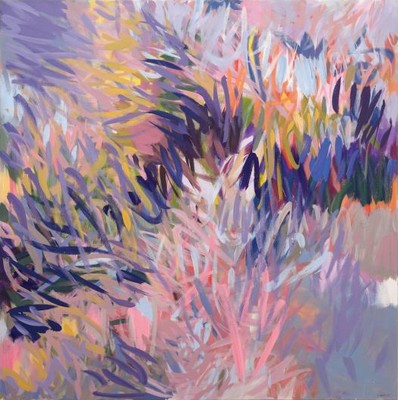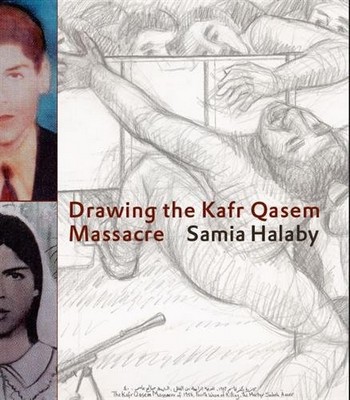Samia Halaby: Flurrying
Ayyam Gallery, Dubai
Through 5 January 2022
Written with a brush, 2019
Acrylic on Canvas, 152 x 152 cm
© Samia Halaby, courtesy Ayyam Gallery
Samia Halaby’s most recent works reflect everything but stillness, each canvas emulating space encompasses energy and movement, brimming intuitive complexity. Samia Halaby invites us to see nature and urban scenes through her vision, immortalizing a dynamic setting through brush strokes and color, creating infinite layers of moving parts.
Continuing her previous explorations towards abstraction, Samia Halaby progressively removes all shapes and boundaries and focuses on motion and space only. While still introducing and studying the component of depth, distance, and location, the artist creates fore and backgrounds in which the stokes interpenetrate, creating a timeline of echoes and variations.
This exhibition highlights both the more geometrical and more calligraphic approach, making a contrasting evolution. The product nonetheless aims to portray space and time and all that lies in between. Thus always creating an invisible set of relationships that our eyes measure and our minds comprehend intuitively.
SAMIA HALABY: Artist StatementThe Sufi thinker Aby Hamed Muhammad al-Ghazali (1058-1111) noted that the seeing of the eye is limited by some failures while the mind is above these failures. As I think of space and air in painting, I am reminded of his words. Slowly, as I intuitively work on my paintings, my consciousness converts intuition into insights. I think of space in our educated visual perception and realize that, to us painters, space is measured as a distance between us and the concrete object we see through that space in the direction of our gaze. Within that space that we gaze at are things that move in the air. Their motion captures our gaze while our memory captures their path.The set of new paintings has been in my studio, in the making for over a year. The paintings capture and trace everything that moves in the air, disturbing its relative stasis or affecting its motion. A few days ago, I could watch large snowflakes flurrying here and there up and down Franklin St. being pushed about and swirled by the air currents of the avenue and wind in the air. The odd partners, Al Ghazali and flurrying snowflakes, concretized for me what I have been painting during the past year.I think of the canvas as space between me and the target of my gaze while my brush marks are activated by energy that puts them in motion. I want to remove all shapes with static boundaries and have only motion. I want eddying, fluctuating, flurrying, patterns of things being blown by the wind obtaining varying speed, adapting with cross currents. I want the energy that scatters, the paths made by all the parts that move to live in a canvas. Growth, gestation, decay, birth, and things I do not yet know make up the ambitious content of my work.I want no borders or boundaries. Shapes should be factored by things that constantly move and fluctuate in motion, always reacting to changing situations, turning into variations, not repetitions. Some moving parts lose energy and congeal together, creating islands of rest; such islands might be scattered by the entry of high energy motion in their midst. All shapes need to be born of the motion of things.We live in space and see all things moving in it. Space, air, water, and our bodies all are made of moving parts. I think of the canvas as space, and my brush-marks are activated by energy that puts them in motion. The final static, unmoving single image that is a painting should represent one condition in a continuing growth process.
ABOUT SAMIA HALABY
Born in Jerusalem in 1936, Samia Halaby is a leading abstract painter and an influential scholar of Palestinian art. Although based in the United States since 1951, Samia Halaby is recognised as a pioneer of contemporary abstraction in the Arab world.
Samia Halaby began her career in the early 1960s, shortly after graduating from Indiana University with an MFA in Painting. While teaching at the Kansas City Art Institute in 1964, she travelled to the Eastern Mediterranean as part of a faculty research grant and studied the geometric abstraction of the region’s Islamic architecture, which has continuously factored into her work. During this time, Halaby launched a series of experiments that would initiate a career-long investigation of the materialist principles of abstraction: how reality can be represented through form.
Also influenced by the abstract movements of the Russian avant-garde, Halaby works with the conviction that new approaches to painting can redirect ways of seeing and thinking not only within the realm of aesthetics but also as contributions to technological and social advancement. This underlying notion has led to additional experiments in drawing, printmaking, computer-based kinetic art, and free-from-the- stretcher painting.
Samia Halaby has been collected by international institutions since the 1970s, including the Solomon R. Guggenheim Museum of Art (New York and Abu Dhabi); Yale University Art Gallery; National Gallery of Art, Washington D.C.; Art Institute of Chicago; Cleveland Museum of Art; Institut du Monde Arabe; and the British Museum.
Selected solo shows for the artist include Ayyam Gallery, Al Quoz, Dubai (2017); Birzeit University Museum, Ramallah (2017); Beirut Exhibition Center, Lebanon (2015); Ayyam Gallery, London (2015, 2013); Ayyam Gallery, Al Quoz, Dubai (2014); Ayyam Gallery, DIFC, Dubai (2011); and Ayyam Gallery, Beirut (2010). She has participated in recent group shows at Katzen Art Center, American University Museum, Washington, USA (2017); Palestine Museum, Birzeit, Palestine (2017); Galerie Tanit, Munich, Germany (2017); The School of Visual Arts, New York, USA (2017); Ayyam Gallery, DIFC, Dubai (2017); Zürcher Gallery, New York, USA (2016); 3rd Qalandiya International Biennial (2016); Darat Al Funun, Amman (2015); the National Academy of Arts, New York (2015); The Guggenheim Museum, Abu Dhabi (2014); Broadway 1602, New York (2014); and Institut du Monde Arabe, Paris (2009).
From the 1960s until the late 1980s, Samia Halaby taught at universities throughout the United States. She was the first full-time female associate professor at the Yale School of Art, a position she held for a decade. Her noteworthy contributions to American academia include a groundbreaking undergraduate studio art program that she introduced to art departments throughout the Midwest.
Samia Halaby’s writings on art have appeared in Leonardo: Journal of Arts, Sciences and Technology, Jerusalem Quarterly, and Arab Studies Quarterly, in addition to edited volumes, while her independently published survey Liberation Art of Palestine: Palestinian Paintings and Sculpture in the Second Half of the 20th Century (2002) is considered a seminal text of Palestinian art history. In 2017 Schilt Publishing released Halaby’s Drawing the Kafr Qasem Massacre while Palestine Books Inc published Growing Shapes: Aesthetic Insights of an Abstract Painter. In 2014 Booth-Clibborn Editions published the artist’s second monograph, Samia Halaby: Five Decades of Painting and Innovation.
Samia Halaby’s recently released book, Drawing the Kafr Qasem Massacre (Schilt Publishing, 2017) has been shortlisted for the prestigious Palestine Book Awards.
Drawing the Kafr Qasem Massacre
Schilt Publishing, 2017
AYYAM GALLERY
B11, Alserkal Avenue, Street 8, Al Quoz 1, Dubai


